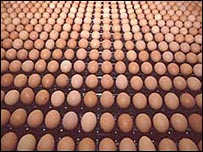Ken Klippen of the U.S. National Association of Egg Farmers writes in support of Will Coggin’s letter to the editor on the Massachusetts ballot initiative on caged layers producing eggs. The group I represent, The National Association of Egg Farmers, is in support of free choice for eggs from different production systems, but the ballot initiative will eliminate that free choice.
 As it relates to food safety, every egg farmer knows that eggs laid on the same ground where manure is located increases the likelihood of contamination.
As it relates to food safety, every egg farmer knows that eggs laid on the same ground where manure is located increases the likelihood of contamination.
The Coalition for Sustainable Egg Supply, a group of scientists investigating the different production systems for eggs, finished their two-year study of the available research including food safety. The conclusions from their analysis of the research is that eggs produced in caged environments had less fecal contamination compared to cage-free eggs. This is logical since cages allow for the eggs to be removed from the environment of the hen compared to cage-free, where the eggs come into contact with manure. Any reasoning person would conclude that keeping eggs clean and away from manure is better from a food safety perspective.
Caged eggs allow for cleaner eggs.
The scientific articles that support this claim are below:
1) The Journal Poultry Science in 2011 [90, pp. 1586-1593] published “Comparison of shell bacteria from unwashed and washed table eggs harvested from caged laying hens and cage-free floor-housed laying hens.”
This study found that the numbers of bacteria on eggs was lower in housing systems that separated hens from manure and shavings.
2) The Journal Food Control published a study June 17, 2014, entitled “Microbiological Contamination of Shell Eggs Produced in Conventional and Free-Range Housing Systems.” The conclusions state, “Battery caged hens are standing on wire slats that allow feces to fall to a manure collection system beneath the hens. Conversely, free-range hens laid their eggs in nest boxes on shavings and the eggs remained in contact with hens, shavings and fecal material until they are collected. The longer contact time with free-range hens, shavings and feces would explain the higher enterobacteriaceae counts (pathogenic bacteria) on free-range eggs as compared to battery caged eggs.”
One of the letters to the editor claims that caged layers increases salmonella, citing a government survey. This is not true. It’s not even logical when considering the federal agency responsible for food safety has issued regulations to protect the consumer. The Food & Drug Administration has issued the regulation entitled Prevention of Salmonella Enteritidis in Shell Eggs During Production, Storage, and Transportation (21 CFR part 118) on July 9, 2009, requiring shell egg farmers to implement measures to prevent SE from contaminating eggs on the farm. If caged environments increased salmonella, it’s inconceivable that FDA would issue regulations governing the production of eggs in caged environments.

.jpg) It’s also bad for business to make customers barf.
It’s also bad for business to make customers barf..jpg) produce industry overseas. The study will also look at how contaminants from these sources that might be introduced to fresh produce are currently controlled.
produce industry overseas. The study will also look at how contaminants from these sources that might be introduced to fresh produce are currently controlled. nearest town, is a neat collection of 350-foot- and 450-foot henhouses covered in white steel siding. They’re linked by overhead pipes that bring in ground corn and soybeans from the farm’s own feed mill and conveyor belts that take out chicken poop.
nearest town, is a neat collection of 350-foot- and 450-foot henhouses covered in white steel siding. They’re linked by overhead pipes that bring in ground corn and soybeans from the farm’s own feed mill and conveyor belts that take out chicken poop.